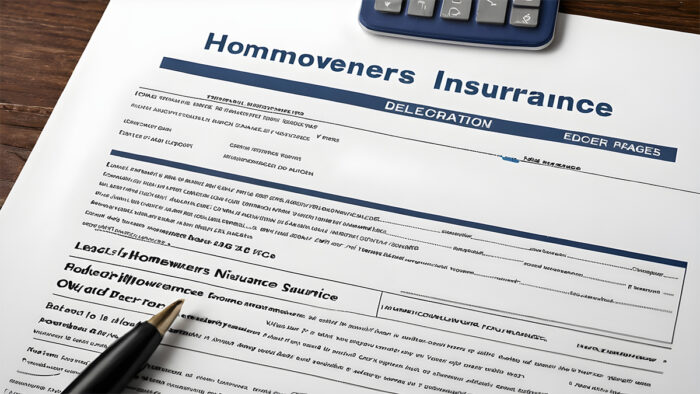Welcome to the snapshot of security that every homeowner desires. As you embark on your journey to safeguard your most cherished space, you’ll encounter a document that holds the keys to your peace of mind: the homeowners insurance declaration page.

Within its carefully curated contents lies a tale of protection, a blueprint of reassurance, and a beacon of resilience against life’s unexpected twists and turns. So, join us as we unveil the canvas upon which your home’s security is painted, revealing the intricate details and fortified defenses that ensure your sanctuary remains steadfast in the face of adversity.
What is Homeowners Insurance Declaration Page?
A homeowners insurance declaration page is a certification issued by your insurance company that sums up the coverage provided by your policy. It is sometimes referred to as ‘dec’. This document contains all the necessary information relating to your home insurance policy.
It simply breaks down everything that’s included in your insurance policies. It contains all the most important and relevant details you need to know about your coverage limits and policy number. When claims are needed to be filed, the declaration page is always required by the insurance company.
Where to Find Your Homeowners Insurance Declaration Page
After you have completed all necessary processes for the process of your homeowners insurance and you eventually buy the insurance policy, or if your policy was renewed, your insurance provider will send you a copy of the declarations page.
A copy of the declaration page is usually sent by mail or electronically. An advanced and modern insurance company might create access for you by allowing you to log into your insurer’s website or their mobile app to download it.
What is the Purpose of A Homeowner Insurance Declaration Page?
Here is the purpose of a homeowners insurance declaration page.
- It helps the policyholder check for their coverage before they proceed with filing a claim. They are familiar with the pros and cons of the insurance company.
- Another purpose of homeowner insurance declaration page is that you are able to get quick information from it rather than read through the entire policy coverage. It contains valuable policy information about the coverage.
If you already have coverage or intend to get one someday for your home, it is very important to note the purpose of getting a homeowners insurance declaration page so you can fully understand how it runs.
Information Available on the Homeowner Insurance Declaration Page
It is very necessary to read through the documents representing your home insurance policy. Starting with the declarations page is paramount. This has the full details of your coverage. Below is the list of information that you will find on your homeowners insurance declaration page.
- At the top of the declaration page, you will find the insurance “company name” and “contact details.”.
- All information concerning your policy will be shown. Policy information like the ‘information about your home’, “policy number” and the “exact day of the policy”.
- “Your personal information is also included on the declaration page. Like your names, mailing, date of birth, address of the insured property, and location.
- The limit of years you have selected for coverage and the end dates will also be included in the declaration page. This coverage includes the structure of your house, medical payments, and personal property.
- The bottom of your declaration carries the premiums. Your premium will be listed alongside the list of the total cost that you are paying for each individual and the amount of discounts available in the policy at the final premium.
The arrangement of a homeowner insurance document declaration page varies from one company to the next, but the details are always common.
Information Not Available on a Homeowner Insurance Declaration Page
Just like there is information available on the homeowners insurance declaration page, there are still things that aren’t included in the declaration page. It could be a quick way to find out what your policy entails, but it cannot be like actual policy documents. A homeowners insurance declaration page doesn’t contain the following:
- The full policy application.
- Endorsements that were carried out.
- The main insurance policy contract.
- Exclusions made for each category of your policy. Damages made by the policyholder out of negligence when carrying out their duties
- Companies’ guidelines and governmental disclosures will not be included.
When you receive your homeowner insurance declaration page, it is very important to read it thoroughly to be sure that all that is in there is exactly what you will be getting.
How to Read a Homeowners Insurance Declaration Page
The insurance declaration page is the best tool to understand your insurance coverage. In it are the full details of what it involves. Therefore, knowing how to read through it is very important. Most modern or advanced homeowner insurance declaration pages consist of about three sections on the page. Here is a detailed explanation of how to best understand each section to ensure everything is in order.
• The First Section on the Declaration Page is the ‘‘Policy Summary’’
The policy summary consists of details about your policy. It is very advisable to take your time to familiarize yourself with all the details about the policy. Check to confirm if the information about the insured property is accurate and if your details as the policyholder are up-to-date. This section also contains your claim agent’s information if you have a claim to file.
• The Second Section Contains the “Summary of Your Coverage”
You must make sure to review the summary of your coverage and the limits of liability for each of them. This coverage could include property, liabilities, and deductibles. Understand what will be covered and what it doesn’t cover. This can help you know when to file a claim with your insurer when the need arises.
• Lastly, it Contains a Breakdown of Your “Total Premium”.
Here you will find the total premium for your insurance policy. Look through to check if your total premium is accurate and well detailed. They give you an overall idea of what you are expected to pay, whether it’s renewed or you just started.
It is important to read through the declaration page properly to familiarize yourself with all that it contains and offers to avoid any potential issues between you and your insurance company’s.
Who May Need a Homeowners Insurance Declaration Page?
The presentation of the homeowner insurance declaration page is sometimes needed when a claim is to be filed or when you have transactions relating to your property. Here are a few people and institutions who might request your homeowner insurance declaration page:
- Homeowners Association
- Legal Advisors
- Home Inspectors
- Insurance Adjusters
- Real estate professionals
Understanding all that the homeowners insurance declaration page brings helps you have all significant policy details under control and can be brought out without fear when and where they need to be issued.
FAQs
Does the Homeowners Insurance Declaration Page Serve as Proof of Insurance?
It can serve as proof of insurance in most cases. Whenever the need to tend to a proof of insurance comes up, your insurance declaration page can serve as a proof of insurance for you.
Can I File for a New Homeowners Insurance Declaration Page When the Initial One is Misplaced?
Yes. You can file for a new homeowners insurance declaration page from your insurance company if you misplaced the initial one. Most insurance companies offer it free of charge to their customers.
What is a Homeowners Insurance Declaration Page Used for?
A homeowners insurance declaration page is used for quick reference to your policy coverage. It can also help the policyholder make decisions correctly and determine when a case needs to be filed.



